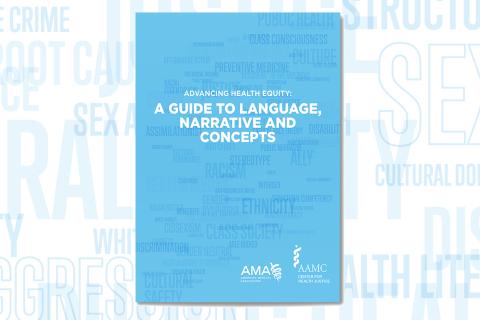Health equity guide overview
In 2019, the AMA established the Center for Health Equity to embed and advance equity across all aspects of health care, including within the AMA itself.
Foundational to the work of the Center, the AMA developed, in partnership with the Association of American Medical Colleges (AAMC) Center for Health Justice, one of the most comprehensive health equity communication guides to support physicians’ conversations with patients.
Designed for physicians and other health care professionals, the Advancing Health Equity: A Guide to Language, Narrative and Concepts provides guidance and promotes a deeper understanding of equity-focused, person-first language and why it matters.
Like science, language and understanding evolve over time, and this guide is not intended to be a definitive and all-encompassing instruction manual. Instead, it was created to give a fresh perspective about the language we commonly use, and to recognize the harmful effects of dominant narratives in medicine.
Better understanding about language and dominant narratives can help ensure that we are indeed centering care around the lived experience of patients and communities without reinforcing labels, objectification, stigmatization and marginalization. An AMA Leadership Viewpoint discusses why this is important to medicine and patient health.
The guide is comprised of three key components to guide physicians and health care professionals. They include:
Part 1: Health equity language
This section of the guide sets out to help the reader recognize the limitations and harmful consequences of some commonly used words and phrases. In their place, we offer equity-centered alternatives.
Part 2: Why narratives matter
Dominant narratives (also called malignant narratives), particularly those about “race,” individualism and meritocracy, as well as narratives surrounding medicine itself, limit our understanding of the root causes of health inequities. Dominant narratives create harm, undermining public health and the advancement of health equity; they must be named, disrupted and corrected.
Part 3: Glossary of key terms
The glossary provides an overview of key terms and concepts that are frequently used in health equity discussions. It is by no means exhaustive, nor is it a definitive list of correct/incorrect answers. Rather, it is intended to serve as a starting point for reflection. It is a guide on current usage of important terms and will be updated over time. Whenever possible, we cite authoritative sources and introduce ongoing debates over definitions.
Download the equity language guide
- Download the complete Advancing Health Equity: A Guide to Language, Narrative and Concepts (PDF).
Additional health equity resources
Prioritizing Equity videos
Critical race theory & intersectionality: A discussion on the history of critical race theory and its applications to the field of medicine as well as health equity. Originally defined by legal scholars in the 1980s, critical race theory has since evolved as a way of looking at structures and histories responsible for racism in the United States. Critical race theory, as a practice, allows health care professionals to confront and dismantle racial injustice and is thus vital to the pursuit of health equity.
The root cause: Panelists discuss recognizing racism as a fundamental and root cause of health inequities, and distinguishing both short-term and long-term implications on health care and public health systems,








